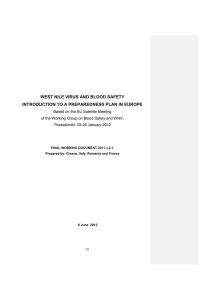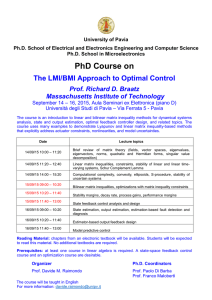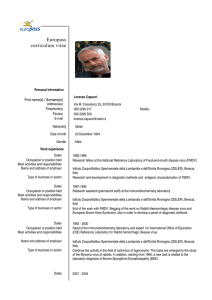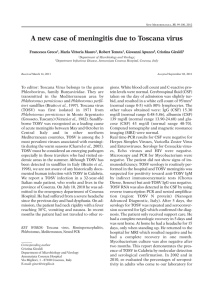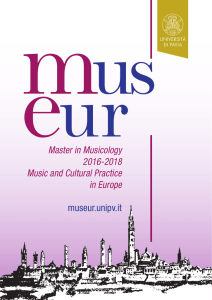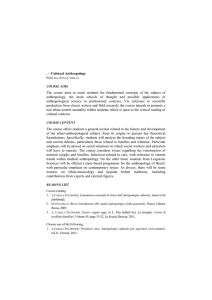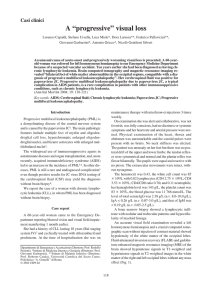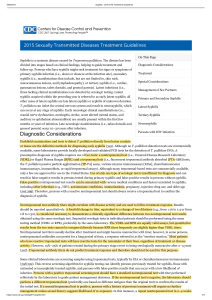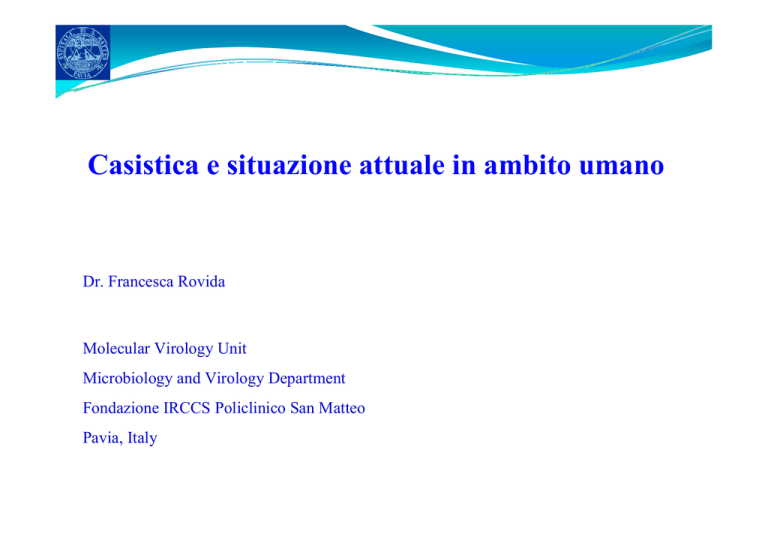
Casistica e situazione attuale in ambito umano
Dr. Francesca Rovida
Molecular Virology Unit
Microbiology and Virology Department
Fondazione IRCCS Policlinico San Matteo
Pavia, Italy
West Nile virus
West Nile virus (WNV) is a mosquito-borne flavivirus.
WNV was first isolated from a woman in the West Nile district of Uganda in 1937.
WNV is widely distributed in Africa, Western Asia, Europe, Australia and North
America.
Person to Person transmission of WNV
• Organ transplantation
• Blood transfusion
•Intrauterine
•Breastfeeding
Who is at risk for infection with West Nile virus?
Anyone living in an area where West Nile virus is present in mosquitoes can get
infected.
•US: West Nile virus has been detected in all lower 48 states (not in Hawaii or Alaska).
Outbreaks have been occurring every summer since 1999.
•The risk of infection is highest for people who work outside or participate in outdoor
activities because of greater exposure to mosquitoes.
Is there a vaccine available to protect people from West Nile virus?
No. Many scientists are working on this issue, and there is hope that a vaccine will
become available in the future.
How soon do people get sick after getting bitten by an infected mosquito?
The incubation period is usually 2 to 6 days but ranges from 2 to 14 days.
This period can be longer in immunocompromised patients.
Clinical presentation
Neuroinvasive disease (1%)
Febrile illness (20-30%)
Asymptomatic infection (70-80%)
Risk factors for severe disease
• Age >60 years
• Diabetes
• Hypertension
•Cancer history
•Chronic renal disease
• Chronic alcohol abuse
Lindsey NP, Am J Trop Mad Hyg. 2012; 87(1):179-184
How is West Nile virus disease diagnosed?
Diagnosis is based on a combination of:
clinical signs and symptoms and
specialized laboratory tests of blood, spinal fluid, urine.
These tests typically detect antibodies that the immune system makes
against the viral infection.
WNV diagnostic testing
Specimens:
• serum
• Serology
• NAT
• cerebrospinal fluid (csf)
•Serology
•NAT
• Urine
•NAT
Zeller HG et al., Eur J Clin Microbiol Infect Dis (2004) 23: 147-156
WNV antibody testing
IgM antibodies in serum or CSF
• performed by commercial ELISA or IFA assay.
• WNV-specific IgM antibodies are usually detectable 3 to 8 days
after onset of illness and persist for 30 to 90 days (longer
peristence has been documented).
• provides presumptive diagnosis of recent WNV infection but
may also result from cross-reactive antibodies after infection with
other flavivirus or from non-specific reactivity.
IgG antibodies in serum and/or CSF
• performed by commercial ELISA or IFA assay.
• WNV IgG generally are detected
persist for many years .
shortly after IgM and
• the presence of IgG alone is only evidence of previous
infection.
• Serum and CSF antibodies MUST be searched for in paired
samples.
Neutralization assay
• mandatory for differentating WNV-specific from cross-reactive
antibodies.
• can also confirm acute infection by demostrating a fourfold or greater
change in WNV-specific neutralizing antibody titer between acute- and
convalescent-phase serum samples collected 2 to 3 weeks apart.
• It requires culturing of WNV and must be performed in BSL3 reference
laboratories by trained personnel.
WNV molecular testing
• Reverse transcriptase-polymerase chain reaction (RT-PCR) can be performed on
serum, CSF and urine, collected early in the course of illness.
• Adoption of multiple PCR techniques is adviced.
West-Nile virus Real-time RT-PCR targeting a conserved region of WestNile
virus lineage 1 and 2 (Linke et al., Virol Methods 2007; 146: 355-358).
Pan-Flavivirus nested RT-PCR (Sánchez-Seco et al., J Virol Methods
2005;126: 101-109; Scaramozzino et al., J Clin Microbiol 2001;39: 19221927).
•Sequencing of PCR products is mandatory for:
• Specificity confirmation
• Epidemiology of circulating WNV strains
JID 2013: 208 (1 October)
JCM 2014 Sep;52(9):3411-3
Possible West Nile neuroinvasive disease (WNND)
pts in endemic or epidemic area presenting with:
•viral encephalitis
•viral meningitis
•polyradiculoneuritis
•acute flaccid paralysis
Possible West Nile fever (WNF)
Pts in endemic or epidemic area presenting with:
•fever ≥38°C
•absence of other concomitant diseases
Probable WNND and WNF
As above +
WNV-specific IgM and IgG or in serum with
seroconversion or a 4-fold increase in IgG titers
Confirmed WNND and WNF
As above +
• WNV isolation from blood, CSF
•detection of WNV RNA in blood, CSF
• WNV-specific IgM in the CSF
•Confirm of WNV IgG-specificity by neutralization
assay
Barzon L et al., JID 2013
Europe
Before 1996 WNV caused only sporadic infections in Europe.
1996: large outbreak of WNV neuroinvasive disease occured in Romania.
1997: outbreaks in human population in the Czeck Republic (5 cases).
1999: 826 pts admitted to hospital in Russia: 183 confirmed cases, 40 deaths.
2003: 7 human cases in France.
Italy (since 2008) and Greece (since 2010) have been the most affected
countries in Europe.
Italy
1998: outbreak in Toscana limited to 14 horses, of
which 6 died (no human cases)
2008: first human cases of WNND and WNF were
detected in the Po river area in northeastern Italy
Gobbi et al., Eurosurveillance, 2009
Barzon et al., Int. J Environ. Res Public Health, 2013
Barzon et al., Int. J Environ. Res Public Health, 2013
West Nile Virus in Lombardia region
•2007-2012, 455 patients with potential WNV disease were investigated, but no
WNV cases were found.
•13 Aug. 2013-7 Oct. 2013, 18 cases of WNV infection were diagnosed.
10 confirmed cases of acute WNV neuroinvasive disease
(3 of them died)
18 cases of WNV
infection
8 cases of acute WNV fever
(7 confirmed and 1 probable)
WNF
6
WNND
Number of cases
5
4
3
2
1
0
32
33
34
35
36
37
38
39
Symptom onset by week (2013)
40
41
42
Sondrio
Lecco
Varese
Como
Bergamo
Monza
Brescia
Milano
Lodi
Pavia
Cremona
Mantova
positive humans
positive birds
positive horses
positive mosquitoes
Patients with WNV neuroinvasive disease
• 9 (90%) males and 1 (10%) females
• 4 Mantova, 2 Cremona, 3 Brescia and 1 Lodi
• median age 75 years (range, 54-89)
• 33% (3/9) case -fatality rate
Patients with WNV fever
• 4 (50%) males and 4 (50%) females
• 1 Mantova and 7 Cremona
• median age 58 years (range, 17-87)
Table 1. Characteristics of human WNV infections, in the Lombardia Region, August-October 2013.
Elisa IgM1
1
Elisa IgG2
RT-PCR3,4
Patient
Age/Sex
Origin
Clinical presentation
Outcome
serum
CSF
serum
CSF
Neutralization
serum
CSF
urine
1
78/M
Mantova
encephalitis
alive
+
+
+
-
+
+
+
NA
2
66/M
Mantova
meningoencephalitis
alive
+
+
+
+
+
-
-
NA
3
89/M
Mantova
encephalitis
dead
+
+
+
-
+
-
-
NA
4
49/M
Cremona
West Nile fever
alive
+
NA
+
NA
+
-
NA
NA
5
55/F
Cremona
West Nile fever
alive
+
NA
-
NA
ND
-
NA
NA
6
75/F
Cremona
encephalitis
alive
+
+
+
+
+
-
-
NA
7
61/M
Mantova
West Nile fever
alive
+
NA
-
NA
ND
-
NA
+
8
54/M
Cremona
encephalitis
alive
+
+
+
-
+
-
-
+
9
17/M
Cremona
West Nile fever
alive
+
NA
+
NA
+
-
NA
-
10
71/F
Cremona
West Nile fever
alive
+
NA
+
NA
+
-
NA
-
11
63/M
Cremona
West Nile fever
alive
+
NA
+
NA
+
-
NA
-
12
27/F
Cremona
West Nile fever
alive
+
NA
+
NA
+
-
NA
-
13
57/M
Lodi
encephalitis
dead
+
NA
+
NA
+
-
NA
-
14
78/M
Brescia
encephalitis
alive
+
+
+
+
+
-
-
-
15
76/M
Brescia
meningoencephalitis
alive
+
NA
+
NA
+
-
NA
NA
16
79/M
Mantova
encephalitis
dead
+
+
+
+
+
-
-
NA
17
87/F
Cremona
West Nile fever
alive
+
NA
+
NA
+
-
NA
-
18
54/M
Brescia
encephalitis
alive
+*6
-6
+*6
-6
ND
-5
+5
+5
WNV IgM Capture DxSelect (Focus Diagnostics); 2 WNV IgG DxSelect (Focus Diagnostics);
real-time RT-PCR WNV L1-2 [14]; 4 Nested RT-PCR pan-Flavivirus [15-16]; 5 real-time RT-PCR Flavivirus [19]; 6 WNV IgG/IgM IIFT (Euroimmun);
* convalescent serum sample;
NA, not available; ND, not done
3
Sequencing of NS5 gene
Partial sequencing of the NS5 gene performed for positive urine samples
demonstrated that the virus was a WNV lineage 2 strain, with > 95% sequence
identity to WNV Rovigo strains circulating in Veneto Region in 2013 (GenBank:
KF647251.1; GenBank: KF5883365.1).
West Nile Virus in Lombardia region in 2014
•21 Aug. 2014-6 Oct. 2014, 15 cases of WNV infection were diagnosed.
13 confirmed cases of acute WNV neuroinvasive disease
15 cases of WNV
infection
2 confirmed cases of acute WNV fever
Patients with WNV neuroinvasive disease
• 11 (85%) males and 2 (15%) females
• 2 Mantova, 4 Cremona, 4 Pavia, 1 Lodi and 1 Piacenza
• median age 76 years (range, 12-86)
Patients with WNV fever
• 1 (50%) male and 1 (50%) female
• 1 Pavia and 1 Cremona
• median age 54 years (range, 39-70)
Table 1. Characteristics of human WNV infections, August-October 2014.
Elisa IgM1
1
RT-PCR3,4
Patient
Age/Sex
Origin
Clinical presentation
Outcome
serum
CSF
serum
CSF
Neutralization
serum
CSF
urine
1
76/M
Pavia
WNND
alive
+
+
+
-
+
-
-
+
2
86/M
Cremona
WNND
dead
+
+
-
-
-
-
-
+
3
56/M
Cremona
WNND
alive
+
+
+
-
+
-
-
+
4
84/M
Pavia
WNND
alive
+
+
+
-
+
-
-
-
5
39/F
Cremona
WNF
alive
+
NA
+
NA
+
-
NA
-
6
72/M
Mantova
WNND
alive
+
NA
+
NA
+
+
NA
-
7
12/M
Pavia
WNND
alive
+
+
+
-
+
-
-
-
8
77/M
Lodi
WNND
alive
+
+
+
-
-
-
NA
9
77/F
Lodi
WNND
alive
+
+
+
+
+
-
-
-
10
78/M
Piacenza
WNND
?
+
+
+
+
+
-
-
+
11
81/F
Pavia
WNND
dead
+
NA
-
NA
+
-
-
+
12
65/M
Mantova
WNND
alive
+
+
+
-
+
-
-
-
13
52/M
Cremona
WNND
alive
+
NA
+
NA
+
-
NA
+
14
70/M
Pavia
WNF
alive
+
+
+
+
+
-
-
-
15
55/M
Cremona
WNND
alive
+
+
+
+
+
-
-
-
2
WNV IgM Capture DxSelect (Focus Diagnostics); WNV IgG DxSelect (Focus Diagnostics);
real-time RT-PCR WNV L1-2 [14]; 4 Nested RT-PCR pan-Flavivirus [15-16];
NA, not available; ND, not done
3
Elisa IgG2
2013
2014
Sondrio
Sondrio
Lecco
Varese
Como
Lecco
Varese
Como
Bergamo
Bergamo
Monza
Monza
Brescia
Brescia
Milano
Milano
Lodi
Lodi
Pavia
Pavia
Cremona
Mantova
positive humans
Cremona
Piacenza
positive humans
Mantova
Molecular Diagnosis on CSFs
(01-06-2013/30-11-2013)
Molecular Diagnosis on CSFs
(01-06-2014/30-11-2014)
Enterovirus
3
Enterovirus
2
Herpes Simplex Virus
3
Herpes Simplex Virus
3
Varicella zoster Virus
2
Varicella zoster Virus
2
West NileVirus
10
West NileVirus
12
Conclusions
•The veterinary and entomological surveillance program of WNV confirmed the
presence of WNV infection in mosquitoes, horses and birds in Lombardia in
summer 2013 and 2014.
•The occurrence of human cases in two consecutive years suggest the
establishment of WNV in Lombardy region.
• WNV infection is presently a Major cause of neurological disorders in
Lombardy during the summer period.
Acknowledgments
Pavia:
Bergamo:
Mantova:
Fausto Baldanti
Claudio Farina
Paolo Costa
Giulia Campanini
Alessandra Tebaldi
Lisa Manzini
Gaetano Filice
Brescia:
Giovanna Gorini
Nicola Bossini
Lorenzo Minoli
Francesco Castelli
Bianca Mariani
Cremona:
Elena Percivalle
Antonio Cuzzoli
Antonella Sarasini
Angelo Pan
Regione Lombardia:
Stefano Possenti
IZSLER:
Maria Gramegna
Fabio Zacchi
Mattia Calzolari
Milano:
Giovanni Gesu
Roma:
MariaRosaria Capobianchi
Concetta Castilletti
Varese:
Paolo Antonio Grossi
Piero Frazzi
Antonio Lavazza
Alessandra Piatti
Davide Lelli
Thank you
for
your attention


